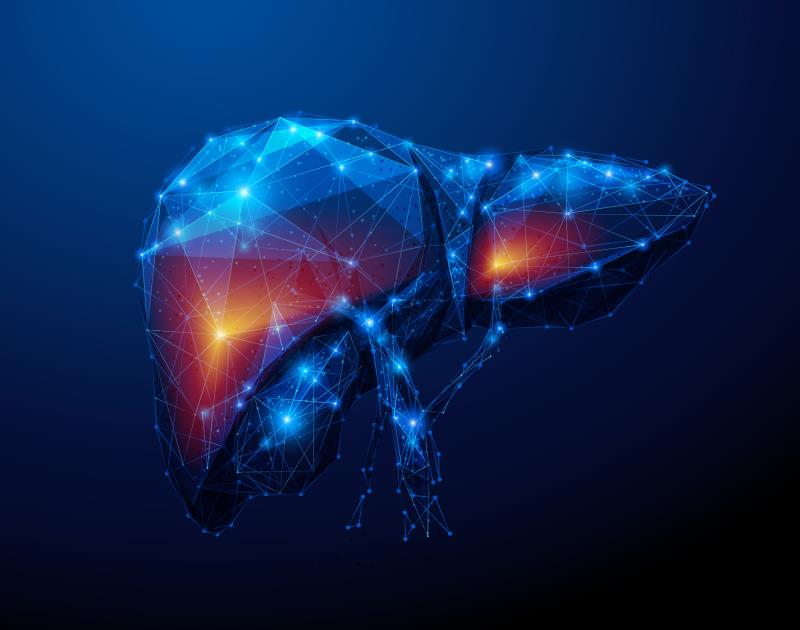Cotadutide trims weight, improves liver markers in T2D patients with NAFLD





In the treatment of patients with type 2 diabetes (T2D) and nonalcoholic fatty liver disease (NAFLD), the first-in-class GLP-1/glucagon dual-receptor agonist cotadutide confers positive effects on body weight, alanine aminotransferase (ALT) levels, and markers of liver fat and fibrosis, although these benefits appear to come with adverse gastrointestinal (GI) events, as shown in a phase IIb study.
One takeaway is that dual agonism delivers greater decreases in ALT as compared with GLP-1 agonism, despite the similar effects on weight loss, according to lead study investigator Dr Philip Ambery of AstraZeneca in Gothenburg, Sweden, who presented their data at this year’s Digital International Liver Congress (ILC).
The 54-week study was designed to assess the holistic metabolic effects of cotadutide with an exploratory analysis of liver biomarkers. In total, 834 adult T2DM patients who were overweight or obese (BMI ≥21 kg/m2) participated. All patients were on metformin monotherapy, and their HbA1c levels ranged 7–10.5 percent. Ninety-one percent of them had fatty liver, and 13 percent had advanced liver fibrosis (NAFLD fibrosis score [NFS] >0.675). Transaminase levels were less than three times the upper limit of normal, which were said to be in keeping with the stage of the study.
After a 2-week run-in, the patients were randomized to receive once-daily subcutaneous cotadutide 100, 200, or 300 µg, placebo, or liraglutide 1.8 mg. Ambery mentioned that liraglutide was not blinded and patients received the standard pen, whereas cotadutide was given in daily pre-filled syringes.
From baseline to week 54, cotadutide produced significant reductions in body weight across all doses relative to placebo (p<0.001) but only at the highest dose when compared with liraglutide (–5.02 percent vs 3.33 percent; p=0.009). These were accompanied by declines in transaminases. [ILC 2020, abstract AS076]
Ambery pointed out that although transaminases were within the normal range effectively, when looking at the highest quartile of baseline ALT, cotadutide yielded much greater decreases at week 54 than did liraglutide: –7.5 percent with 100 µg, –12.01 percent with 200 µg, and –14.1 percent with 300 µg vs –3.21 percent with 1.8 mg.
There were also favourable changes noted in hepatic markers. NFS decreased significantly across all cotadutide doses vs placebo (p≤0.001), but the improvement in fibrosis-4 index was only substantial at the 300-µg dose (p=0.010). Accordingly, Pro-C3 levels dropped (–0.38 percent) with the highest cotadutide dose, whereby it increased with liraglutide (7.96 percent) and placebo (13.04 percent).
However, treatment-emergent adverse events (AEs) occurred more frequently with cotadutide. Specifically, 41 percent of patients on the highest dose reported nausea and 20 percent of those on the 200-µg dose reported vomiting, as opposed to only 15.5 percent and 2.7 percent on liraglutide and 10.7 percent and 4.5 percent on placebo, respectively.
The relatively high incidence of GI events attracted attention in the question-and-answer forum, where it was asked whether the weight-loss benefit was a drug-specific effect or simply the side effect of patients eating less due to nausea and vomiting.
“It’s probably the case that the combination of glucagon and GLP-1 causes slightly more accentuated reduction in GI emptying in the first few weeks of treatment,” Ambery explained.
He pointed out that while “good and meaningful,” the weight loss achieved with the dual agonist “was not spectacular,” emphasizing that “the changes in transaminases persisting between the 6- and 12-month period suggest that it's absolutely not just nausea causing you to eat less.”
In a statement, Dr Luca Valenti, a Scientific Committee member of the European Association for the Study of the Liver from the University of Milan, Italy, said that clinical studies targeting “GLP-1 and gastrointestinal hormone receptors are promising approaches for the treatment of nonalcoholic steatohepatitis, which are worth to be further evaluated.”